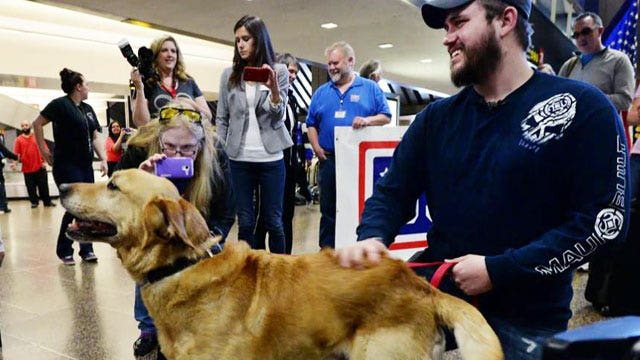Mankind has always had a special relationship with dogs.
For thousands of years, dogs have comforted us, protected us, and given us their unconditional love. Time and time again through the ages they have proven why they are considered our best friends. And nowhere is that remarkable bond between dogs and people been more critical than on the battlefield.
Soldiers have been relying on these four-footed comrades-in-arms since the beginning of organized warfare.
[pullquote]
The Romans were known to have use dogs in their military campaigns to disrupt and overwhelm the enemy. During the Civil War, dogs were reported to have been used to guard soldiers. In the course of World War I, thousands of dogs were used as couriers. During the second World War, the Marines used dogs in the Pacific archipelago to locate enemy positions. And in Vietnam some 4,000 dogs were used to lead jungle patrols, saving many lives.
More recently, some 2,500 military working dogs and contract working dogs worked side by side with our soldiers in Afghanistan and Iraq. And most famously, a Belgian Malinois war dog named Cairo was an integral part of the Navy SEALs team that helped kill America’s arch-nemesis Usama Bin Laden during a daring raid in 2011.
Today, military dogs are more important than ever in keeping our service men and women safe. With noses that are 100,000 times more sensitive than humans’ giving them an unparalleled ability to sniff out and detect weapons caches and Improvised Explosive Devices, it is estimated that each military working dog saves the lives of between 150-200 soldiers.
When not keeping our warriors out of harm’s way, the dogs provide our troops with companionship and an invaluable sense of normalcy and home under almost unimaginable circumstances.
Clearly a war dog is a soldier’s best friend.
That’s certainly true for U.S. Army Staff Sergeant James Harrington, who served for four years with Military Working Dog Ryky, a seven-year-old Belgian Malinois, to locate hidden explosives. Ryky served with him on two combat deployments in Iraq from 2008 to 2009 and in Afghanistan from 2010 to 2011, working with Special Operations on especially dangerous tasks. One day, their convoy was ambushed and the two sprang into action. They left the vehicle with no regard for their own safety and cleared a path to the damaged lead vehicle, allowing the injured soldiers to escape. For his remarkable courage under fire Ryky was awarded the K-9 Medal for Exceptional Service.
Faced daily with life or death situations, the bond between these dogs and those who work with them is nearly unbreakable. Yet when our human warriors end their tours of duty and return home, their faithful military dogs do not always follow.
We applaud the efforts of the military and animals lovers everywhere for the progress that has been made to bring home our military heroes. But some of these heroes are slipping through the cracks.
If a military working dog is retired in a non-combat zone overseas, then the military does not provide transportation home since they are no longer considered military dogs, and therefore, not legally allowed to be transported on military aircraft.
The solution is simple: Military working dogs should be brought home to U.S. soil before being retired. And, their former handlers, who have the strongest bond with these animals, should be given the first chance to adopt.
We believe this should be the case for all our military war dogs. Furthermore, there are no regulations to bring home the many contract working dogs (CWDs) owned by private companies. While many contractors are doing a good job to care for and repatriate these animals, we would like to see some requirements in the government contracts for such private companies to ensure their well-being and return them to U.S. soil, again for adoption by their former handlers if possible.
A second and vitally important issue is the veterinary care for these hero dogs, regardless of contract or military classification. While the Secretary of Defense may establish a system for the medical care of retired working dogs, such regulations prohibit federal funding. We call on the private sector to embrace the health and wellbeing of these retired hero dogs by funding a veterinary care program with American Humane Association.
This is why we are taking to Capitol Hill today with three military hero dog teams we recently reunited, including Sgt. Harrington and Ryky, to talk about the need to bring home all of our warrior dogs and reunite them with their hero handlers.
American Humane Association has been working with Mission K9 Rescue to bring home these hero dogs so they, too, can enjoy a hero’s welcome and a happy, healthy retirement after a lifetime of service to their country. In June Sgt. Harrington was reunited with Ryky. Now, he says he plans to “let her be a dog and chill out on the couch – she’s earned it.”
We think all war dogs have.

